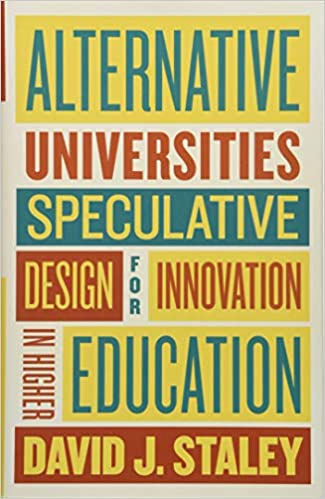Alternative Universities: Speculative Design for Innovation in Higher Education
What if every college student had to major in three subjects, unrelated to one another? What if colleges built degrees around a series of global experiences? These are among the speculative considerations of Alternative Universities: Speculative Design for Innovation in Higher Education. The author of the book, David J. Staley, sets forth a series of possible models for higher education, not restricting himself to those immediately possible or practical.
At a time when the value, cost, and structure of traditional universities are being questioned globally, Staley doesn’t just offer critique; he sketches out bold, speculative alternatives that challenge the entrenched norms of academia. Rather than suggesting incremental tweaks, he invites readers to reimagine the university itself from the ground up.
Staley presents a series of hypothetical university models, each radically different from the traditional research university. These include institutions like “The Interface University,” which is built around networked collaboration rather than departments, and “The Nomad University,” where learning happens in different global locations, emphasizing adaptability and cultural immersion. These scenarios aren’t science fiction; they’re grounded in existing trends and technologies, making them feel both aspirational and entirely plausible.
Parents reading this may initially find the proposals unconventional, even unsettling, especially if they’re envisioning their child’s future within the familiar ivy-covered campus. But Staley makes a persuasive case that the world our children will graduate into demands more flexible, agile, and creative forms of higher learning. In this light, Alternative Universities becomes a roadmap for how education can evolve to meet the demands of the 21st century economy and society, rather than clinging to 19th-century models.
One of the book’s most powerful takeaways is that innovation in higher education doesn’t just mean adding online courses or digital tools. It means rethinking foundational questions: What should students learn? How do they learn best? Who decides what counts as knowledge? Staley encourages readers—educators, administrators, and parents alike—to approach higher education as a design challenge, rather than a fixed institution.
The author blends scholarly insight with an almost entrepreneurial spirit, offering a kind of speculative blueprint that invites experimentation, not dogma. This makes the book ideal not only for academics but also for forward-thinking parents who want to understand how the future of education might look for their children, and perhaps how they can help shape it.
Our aim is to help our children discover their talents, realise their full potential, and develop a passion for life-long learning.






